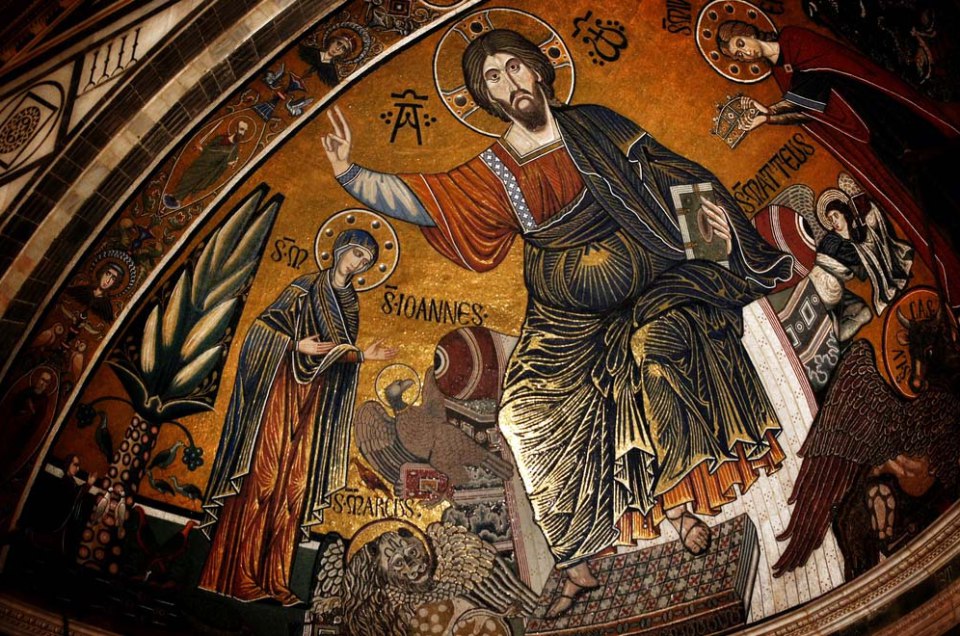Florence is one of the most historic cities in Europe but also has one of the most congested historic centers. The crowds of tourists that fill every must-see attraction can be overwhelming for a visitor to Florence, but getting off the beaten path is easy there. The city is rich in historic places that are easily reached and make excellent alternatives to some of the usual stops.
Instead of walking to Piazzale Michelangelo, walk a little farther up to San Miniato al Monte
Piazzale Michelangelo sits just above Florence, offering some of the most beautiful views of the city, but it can be packed with tour buses and other visitors trying to snap photos of the city below. Just up the hill from Piazzale Michelangelo sits San Miniato al Monte, one of the oldest churches in Florence. Built in the 11th century, it is one of the best examples of Romanesque architecture. Highlights include the geometric decorations on the floor and walls as well as the beautiful interior and exterior mosaics. Monks run a small shop next to the church, which you can visit as you walk around the grounds and see the old cemetery.
The views of Florence from here are stunning. Entrance to the church is free, and you might even hear the monks singing if you come at just the right time! The best way to reach San Miniato al Monte is to cross the river and walk down the Arno until Viale G. Poggi and ascend the winding green walkways until Piazzale Michelangelo, where you will see the church just above the square.
See a more authentic Florence and visit an artisan’s studio
Florence has long been known for its fine artisan products, from traditional Florentine paper to leather, from fine jewelry to colorful ceramics. As factories and companies with brand names have made it harder for the independent artisan to make a living, now is the time to visit artisans before their work slowly becomes harder to locate. In Florence, the best place to find their workshops is the Oltrarno district, just across the Arno River from the historic center of Florence.
The Oltrarno neighborhood has its fair share of historic sights, including the Palazzo Pitti and Brancacci Chapel, but shows a more authentic side of Florence. It is here that you can easily see locals crowded around bars enjoying an evening snack and glass of wine. Meals of typical Tuscan cuisine await in tiny trattorias. As you walk the streets, you will see artisans working in their studios, many of which are open for visitors.
Visit the city’s small shops
Florence is a wonderful place to window-shop, not just because the window displays are so beautifully prepared, but also because they reflect the culture and history of this great city. Instead of perusing the outdoor markets, which sell mostly cheap souvenirs and leather made in foreign countries, look for shops on the city’s smaller streets and in the Oltrarno neighborhood. Florence is known for its leather, traditional paper, and ceramics; all of these come from the strong tradition of artisanship, so by supporting the small shops that sell handmade products, you are supporting this part of their cultural heritage. Other small shops worth a visit are those selling wine, cheeses, salami, olive oil, and other local food products.
Try some of the less famous museums and churches
Some of Florence’s most famous attractions are its museums and churches, which are almost always crowded and, unless you buy a museum card, can lead to hours waiting in lines. However, because Florence was the center of the Renaissance, there are many other places to experience this city’s historic art and architecture. Besides the usual stops of the Uffizi, the Accademia, and Santa Croce, two less-known must-sees are the Bargello Museum for the finest collection of Renaissance sculpture and the Palatine Gallery for its stunning collection of painting by Renaissance and Baroque masters. Excellent examples of Renaissance architecture can be seen at the Pazzi Chapel next to Santa Croce and at San Lorenzo and the adjacent Medici Chapels, designed by Michelangelo. The church of Santa Maria Novella, probably the most beautiful church in Florence, is worth a quick stop to see some of the city’s finest frescoes. For a unique museum visit, try the intimate experience of San Marco, a former monastery where Renaissance artist and monk Fra Angelico painted a fresco in each monk’s cell. To see the inside of a Renaissance home and get a feeling for what life was like then, be sure to visit Palazzo Davanzati. There are many more museums in Florence where visitors can not just see art but also learn about science and natural history, so through a little research, visitors can find a museum that suits their interests.
Escape to the Bardini Garden
Next to the huge, extravagant Boboli Gardens lies the much smaller and quieter Bardini Garden. This garden is part of an old villa, set on a hillside across the Arno River from Florence’s historic center. The views of Florence from the garden are spectacular, especially just before sunset when the Tuscan light shines from just behind the hills that surround Florence. Recently reopened after several years of restoration, the garden includes a wisteria-covered tunnel, sculptures, and mosaics. If you are there in the off-season, you just might have the garden to yourself. The garden has two entrances, so you can enter through one and exit through the other. One entrance is on Via de Bardi in the Oltrarno district, while the other takes you down the old Costa San Giorgio and connects to the Boboli Gardens.
